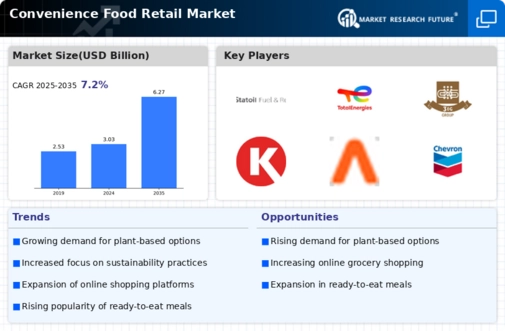Rising Urbanization
The Global Convenience Food Retail Market Industry is experiencing a notable surge due to increasing urbanization. As more individuals migrate to urban areas, the demand for convenient food options rises. Urban dwellers often lead busy lifestyles, which drives the need for quick meal solutions. In 2024, the market is projected to reach 3.03 USD Billion, reflecting the growing preference for ready-to-eat meals and snacks. This trend is particularly evident in densely populated cities where time constraints make convenience food an attractive option. The urbanization trend is expected to continue, further propelling the market forward.
Market Growth Projections
The Global Convenience Food Retail Market Industry is poised for substantial growth, with projections indicating a market size of 6.27 USD Billion by 2035. This growth is underpinned by various factors, including urbanization, changing consumer lifestyles, and technological advancements. The compound annual growth rate of 6.84% from 2025 to 2035 suggests a robust expansion trajectory. As convenience foods become increasingly integrated into daily life, the market is likely to witness a diversification of product offerings, catering to a wider array of consumer preferences. This growth presents opportunities for retailers to innovate and adapt to the evolving landscape of convenience food.
Health and Wellness Trends
Health and wellness trends are increasingly influencing the Global Convenience Food Retail Market Industry. Consumers are becoming more aware of the nutritional content of their food, leading to a demand for healthier convenience options. Retailers are responding by introducing products that are not only convenient but also cater to health-conscious consumers. This includes organic, gluten-free, and low-calorie options that align with modern dietary preferences. The market's growth is indicative of this trend, as it is projected to reach 3.03 USD Billion in 2024. As health awareness continues to rise, the market is likely to evolve further, adapting to the changing preferences of consumers.
Technological Advancements
Technological advancements play a pivotal role in shaping the Global Convenience Food Retail Market Industry. Innovations in food processing, packaging, and distribution have made it easier for retailers to offer a diverse range of convenient food products. For instance, advancements in refrigeration technology ensure that perishable items maintain freshness for longer periods, thus expanding the shelf life of convenience foods. Additionally, e-commerce platforms are becoming increasingly popular, allowing consumers to order food products online with ease. This technological evolution is likely to contribute to a compound annual growth rate of 6.84% from 2025 to 2035, reflecting the market's adaptability to modern consumer needs.
Increased Disposable Income
The Global Convenience Food Retail Market Industry is benefiting from rising disposable incomes across various demographics. As consumers have more financial flexibility, they are more inclined to spend on convenience foods that save time and effort. This trend is particularly pronounced in emerging markets, where a growing middle class is driving demand for ready-to-eat meals and snacks. The increased purchasing power allows consumers to prioritize convenience without sacrificing quality. This shift is expected to sustain market growth, with projections indicating a potential market size of 6.27 USD Billion by 2035. Retailers are responding by diversifying their product offerings to meet this demand.
Changing Consumer Lifestyles
The Global Convenience Food Retail Market Industry is significantly influenced by evolving consumer lifestyles. As people become more health-conscious yet time-strapped, there is a growing demand for nutritious yet convenient food options. This shift is evident in the increasing availability of healthier ready-to-eat meals and snacks. Consumers are seeking products that align with their busy schedules without compromising on quality. The market's growth trajectory suggests that by 2035, it could reach 6.27 USD Billion, indicating a robust response to these lifestyle changes. Retailers are adapting their offerings to cater to this demographic, enhancing the market's dynamism.





















